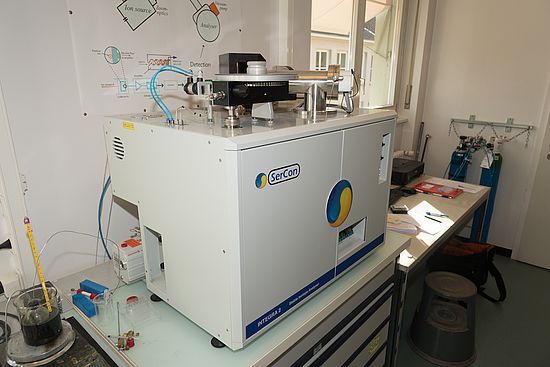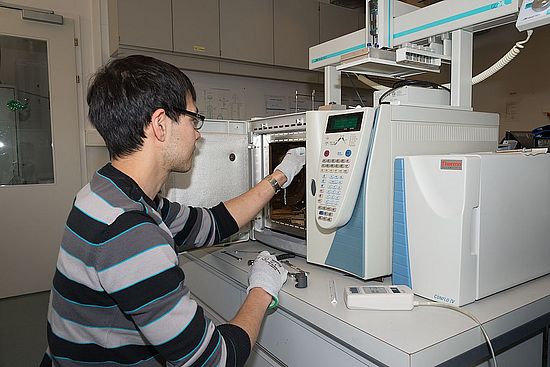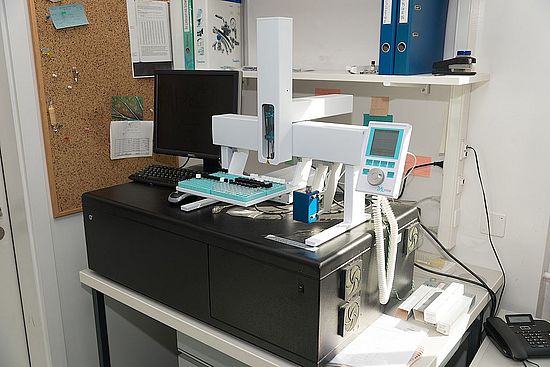Carbon, nitrogen, and oxygen isotope analysis of solids by EA-IRMS

Solid materials, such as sediments, freeze-dried extracts, soil and plant samples, or bone samples from archaeological studies are analyzed using a Sercon Integra II IRMS with integrated elemental analyzer. C and N isotope analysis are commonly performed simultaneously. For oxygen analyses we use a high-temperature conversion analyzer (TC-EA) coupled to our Delta V Advantage IRMS via a ConFlo IV interface.
Compound specific asotope analysis (CSIA) by GC-IRMS

We routinely perform compound-specific δ13C analyses in a variety of organic compounds using GC-combustion IRMS using a GC IsoLink, coupled to our Delta V Advantage by a ConFlo IV. Prior to the GC-IRMS analyses, compound groups are isolated from bulk sample materials using common multi-step extraction techniques, and non-volatile/high-polarity compounds are derivatized (e.g., by silylation or esterification) to allow for chromatographic separation. We use our set-up mostly for the analysis of bacterial and archaeal lipid biomarkers.
Nitrate and nitrite isotope analysis with the denitrifier and azide methods

NOx isotope measurements represent one of the main activities in our lab. For N and O isotopic analysis of NO3- and NOx dissolved in water samples, sample NO3-/NOx is transformed into N2O by denitrifying bacteria that lack N2O reductase activity. For the analysis of the N2O we use our Delta V Plus IRMS coupled to a modified Gasbench II pre-concentration unit adapted for very low N2O concentration. This method allows the analysis of O-isotope ratios in seawater NO3-, and only minute sample quantities are required for reliable isotope measurements. Moreover, other forms of N, such as NH4+ and dissolved organic N (DON) can be quantitatively converted to NO3, so that the capacity to measure the δ15N of NO3- allows access to a range of other forms of N as well. NO2- N and O isotope ratios are measured by conversion to N2O by the azide reduction method and subsequent IRMS analysis.
Nitrous oxide (N and O) isotope analysis
For natural abundance and labeled N isotopic analysis of N2O in air or in headspace samples, we use the setup described above for N2O, using the same modified Gasbench II pre-concentration unit. The N2O from 160ml vials is cryo-trapped and concentrated in two sequential liquid nitrogen traps and separated from interfering CO2 in a GC. Sample requirement is as low as 1 nmol N. The 8-cup configuration of our IRMS also allows analysis of the isotopomeric composition (i.e., the intramolecular 15N site preference) of N2O.
Carbon and oxygen isotope analysis of carbonates
For the C and O isotopic analysis of carbonates (from sediments, rocks, soil and bone/tooth samples) we use a Gasbench II coupled to our Delta V Advantage . Samples in evacuated exetainers are treated with phosphoric acid, and the evolved CO2 is purged from the vials through double-needle autosampling. The δ13C of dissolved inorganic carbon in water samples is analyzed analogously.
Carbon dioxide, dinitrogen and oxygen gas isotope analysis
For natural abundance isotopic analysis of CO2 and N2 in air or headspace samples, we use the Gasbench II - Delta V Advantage instrumentation. 15N-labelled N2 is analyzed by manual injection using a modified set-up of the Sercon Intergra II or the Gasbench II - Delta V Plus instrument (employing the amplifier gain switching capability for the cup detecting m/z=30). Isotopic analyses of dissolved O2 are also performed by manual injection into the modified set-up of the Sercon Integra 2 instrument.
Oxygen and hydrogen isotope analysis of water

For the isotopic analysis of water samples, we use a laser absorption spectroscopy water isotope analyzer (Los Gatos Research).
Quick Links
Social Media
